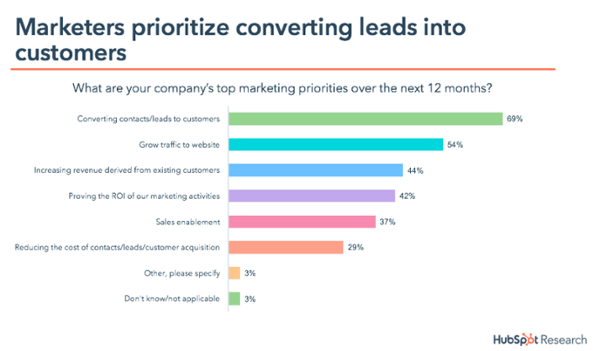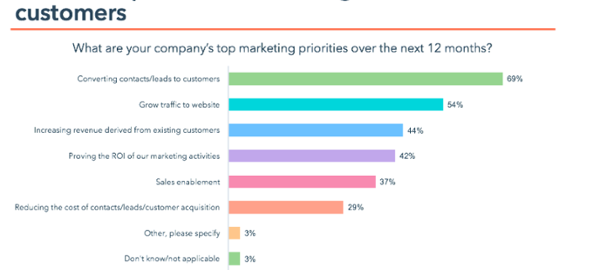— July 5, 2018
The digital era has changed the way we do business, and it’s important for marketers to keep up with the demands of their prospects by building a well-oiled lead generation machine.
Lead generation is broken down into sets of marketing activities that correspond with stages of the buyers journey, starting with generating traffic, then converting visitors into leads, and eventually converting those leads into customers. In fact, according to the 2018 State of Inbound report, a marketer’s number one priority is converting leads to customers.

Yet, lead generation remains a real challenge for most. As data indicates, 88 percent of consumers research their buys online before making a purchase. As marketers, we need to build a digital marketing strategy that provides value to the buyer through that research process, generating not just traffic but qualified leads.
Below we offer four tips that will help you build a well-oiled digital marketing, lead generation machine.
Use Content Marketing to Establish Thought Leadership
If you haven’t started producing content already, this should be one of the first steps in your lead generation strategy. According to a survey by Demand Gen Report, 96 percent of B2B buyers want content with more input from industry thought leaders and 47 percent of buyers viewed three to five pieces of content before engaging with a sales rep.
Garner leads by becoming a subject matter expert on topics or pain points that your product or service solves. Regularly post blogs, news, and tips regarding your industry. Also, produce extensive guides that visitors can download on your website. This allows you to collect data from people that download your guides so you can enroll them into lead nurture programs and keep them engaged by sharing more about your product or service. You may even turn them into customers.
Don’t forget to promote the content you create using online marketing methods such as SEO, social, and email. Great content won’t make a difference if people can’t find it. A survey done by FormStack suggests that organic search is the largest source of high-quality leads, so be sure to spend some time optimizing your content for search engines.
Leverage Paid Social
Social media can be a powerful channel for lead generation. In order to be successful at acquiring leads via social media, you must invest time and effort in building an engaged audience so you can convert those individuals into leads. The first challenge is figuring out which tool is right for your business. You can run paid social ads on Facebook, Twitter, LinkedIn, Instagram, and even Pinterest.
Most internet users are on Facebook, so around 84 percent of marketers choose to use this platform to drive traffic and acquire leads. One of my favorites for lead generation is Facebook Lead Ads. This ad format allows contacts to submit their information without ever leaving Facebook. Strategies for campaigns can include “Subscribe to Our Newsletter” or “Limited Time Offer – 20% Off Your First Purchase.” Lead Ads is also a great outlet for remarketing campaigns because most of the time your website visitors will see the ad and you can use this opportunity to provide an incentive to send them back to your sales funnel.
Facebook removes the friction and lowers acquisition cost, providing a much better user experience and hopefully driving more leads for your business.
Optimize Your Site for Local SEO
Organic search is arguably one of the most valuable long-term lead generation strategies. Yet, with over 200 factors influencing how Google will rank your website within SERPs (search engine results pages), it’s difficult to know where to start. I believe a heavy hitter for lead generation is spending time optimizing local SEO. According to WordStream, 72 percent of consumers who did a local search visited a store within five miles of their location they searched.
Local SEO will allow your business to tap into the surrounding community and help users find you when you’re needed most. As mobile continues to dominate, local SEO can make a big difference in driving more customers to your front door. Start by ensuring your NAP (Name, Address, and Phone) is consistent on your website and within listings such as Yelp, Facebook, and Google My Business. Another good idea is to ask satisfied customers to leave a review or make it very easy for customers to review your business. Reviews on third-party platforms increase your chances of being found by qualified prospects without having to pay a dime! Also, ensure your website Title Tag includes a main key phrase that you want to rank for in addition to your city, state, or neighborhood (e.g., “overnight fly fishing Colorado”). Give it some time, and then test your business by searching your keywords and seeing where you rank.
Segmented Email Marketing
Although it may be one of the older tactics, email marketing can be a very powerful tool when trying to reach prospects or upsell existing customers. It’s important to adapt your email marketing strategy by tailoring your messaging to target specific segments of your customer database. Right now, marketing automation is a popular method to help marketers automatically send highly targeted emails to leads. Synced with your CRM, leads can be placed into a workflow so once they fill out a website form they are nurtured with content that matches their specific interests. This could include follow-up emails with great content and a CTA (call to action) to subscribe to your blog.
As you learn more about each lead, you can tailor your messaging to move them down the funnel. According to Forrester Research, companies that nurture their leads see 50 percent more sales-ready leads than their non-nurturing counterparts at a 33 percent lower cost. Having the ability to capture website visitor data and couple that data with behavioral triggers has allowed marketers to get a lot smarter about the inbox.
Though we’ve only named a handful of lead generation strategies, whichever you choose to experiment with next, be sure you keep testing. This will help you gain an in-depth understanding of how to effectively strategize and implement digital marketing campaigns in order to move the bottom line.
Digital & Social Articles on Business 2 Community
(54)
Report Post





